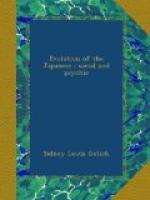“Shinto, which means literally ‘the way of the Gods,’ is the name given to the mythology and vague ancestor-and nature-worship which preceded the introduction of Buddhism into Japan—Shinto, so often spoken of as a religion, is hardly entitled to that name. It has no set of dogmas, no sacred book, no moral code. The absence of a moral code is accounted for in the writings of modern native commentators by the innate perfection of Japanese humanity, which obviates the necessity for such outward props.... It is necessary, however, to distinguish three periods in the existence of Shinto. During the first of these—roughly speaking, down to A.D. 550—the Japanese had no notion of religion as a separate institution. To pay homage to the gods, that is, to the departed ancestors of the Imperial family, and to the names of other great men, was a usage springing from the same soil as that which produced passive obedience to, and worship of, the living Mikado. Besides this, there were prayers to the wind-gods, to the god of fire, to the god of pestilence, to the goddess of food, and to deities presiding over the sauce-pan, the caldron, the gate, and the kitchen. There were also purifications for wrongdoing.... But there was not even a shadowy idea of any code of morals, or any systematization of the simple notions of the people concerning things unseen. There was neither heaven nor hell—only a kind of neutral-tinted Hades. Some of the gods were good and some were bad; nor was the line between men and gods at all clearly drawn.”
The second period of Shinto began with the introduction of Buddhism into Japan, in which period Shinto became absorbed into Buddhism through the doctrine that the Shinto deities were ancient incarnations of Buddhas. In this period Shinto retained no distinctive feature. “Only at court and at a few great shrines, such as those of Ise and Idzumo, was a knowledge of Shinto in its native simplicity kept up; and it is doubtful whether changes did not creep in with the lapse of ages. Most Shinto temples throughout the country were served by Buddhist priests, who introduced the architectural ornaments and the ceremonial of their own religion. Thus was formed the Ryobu Shinto—a mixed religion founded on a compromise between the old creed and the new, and hence the tolerant ideas on theological subjects of most of the middle-lower classes, who worship indifferently at the shrines of either faith.”
The third period began about 1700. It was introduced by the scholarly study of history. “Soon the movement became religious and political—above all, patriotic.... The Shogunate was frowned on, because it had supplanted the autocracy of the heaven-descended Mikados. Buddhism and Confucianism were sneered at because of their foreign origin. The great scholars Mabuchi (1697-1769), Motoori (1730-1801), and Hirata (1776-1843) devoted themselves to a religious propaganda—if that can be called a religion which sets out from the principle that the only two things needful are to follow one’s natural impulses and to obey the Mikado. This order triumphed for a moment in the revolution of 1868.” It became for a few months the state religion, but soon lost its status.[CB]




